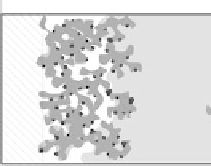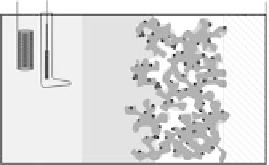Environmental Engineering Reference
In-Depth Information
15.3 MODEL SYSTEMS TO STUDY SIZE EFFECTS
IN ELECTROCATALYSIS
In PEMFCs, the membrane electrode assembly (MEA, Fig. 15.2a) is a multilayer
sandwich composed of catalytic layers (CLs) where electrochemical reactions
take place, gas-diffusion media providing access of gases to the CLs, and a proton
exchange membrane (PEM) such as Nafion
w
. The CL is a multiphase multicomponent
medium comprising:
†
a catalyst, usually nanometer-sized noble metal particles supported on porous
carbon materials, accelerating the rates of electrochemical reactions
†
an ionomer, allowing flow of protons through the MEA
†
gas- and liquid-filled pores, providing access of the reagents to and the products
from the catalyst surface
In practice, the catalytic layers are prepared by brushing or spraying “catalyst ink”
(a suspension of the catalyst particles in water and/or an organic solvent with addition
of ionomer) either onto diffusion media (carbon paper or carbon cloth, also referred to
as substrates), resulting in so-called catalyst-coated substrates (CCS), or directly onto
Figure 15.2 Schematic representation of different electrochemical cell types used in studies of
electrocatalytic reactions: (a) proton exchange membrane single cell, comprising a membrane
electrode assembly; (b) electrochemical cell with a gas diffusion electrode; (c) electrochemical
cell with a thin-layer working electrode; (d) electrochemical cell with a model nonporous elec-
trode. CE, counter-electrode; RE, reference electrode; WE, working electrode.









































Search WWH ::

Custom Search